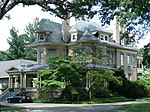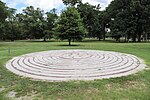Hermitage Road Historic District
Colonial Revival architecture in VirginiaGeorgian Revival architecture in VirginiaHistoric districts on the National Register of Historic Places in VirginiaNRHP infobox with nocatNational Register of Historic Places in Richmond, Virginia ... and 6 more
Neighborhoods in Richmond, VirginiaRomanesque Revival architecture in VirginiaStreetcar suburbsTudor Revival architecture in VirginiaUse mdy dates from August 2023Victorian architecture in Virginia

Hermitage Road Historic District (HRHD) is a Northside neighborhood in the independent city of Richmond, Virginia. The district is a Richmond Old and Historic District, as well as being listed on the Virginia Landmarks Register and the National Register of Historic Places. The historic district consists of properties built in different architectural styles (Victorian, Tudor, Arts and Crafts, Georgian, Colonial Revival, etc.) located in the 3800 to 4300 blocks of Hermitage Road, this portion of which is designated as State Route 161, which crosses over Interstate 95 at the north end of the 4300 block.
Excerpt from the Wikipedia article Hermitage Road Historic District (License: CC BY-SA 3.0, Authors, Images).Hermitage Road Historic District
West Laburnum Avenue, Richmond Ginter Park
Geographical coordinates (GPS) Address Nearby Places Show on map
Geographical coordinates (GPS)
| Latitude | Longitude |
|---|---|
| N 37.58415 ° | E -77.462547222222 ° |
Address
West Laburnum Avenue
23227 Richmond, Ginter Park
Virginia, United States
Open on Google Maps





